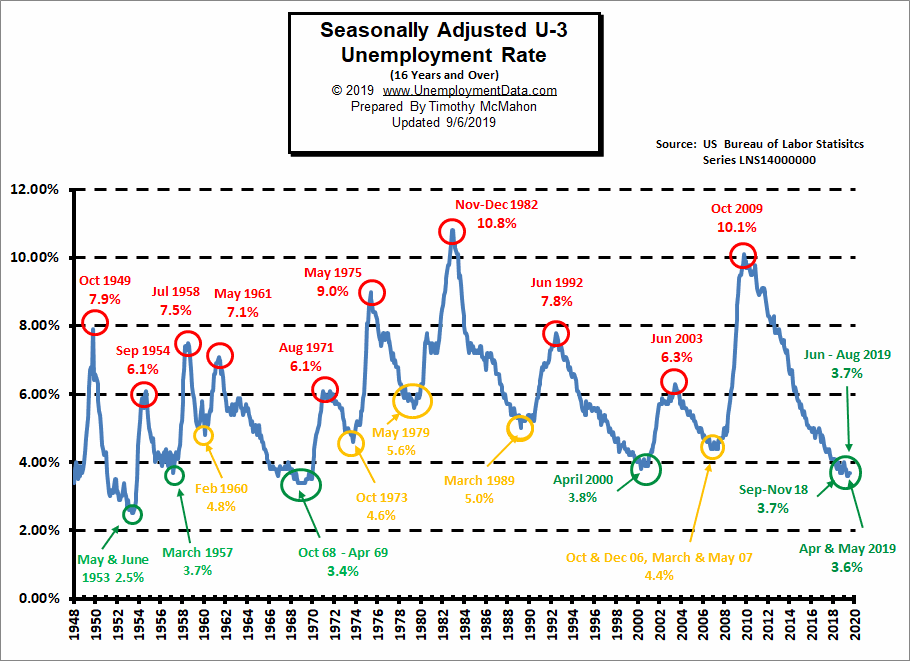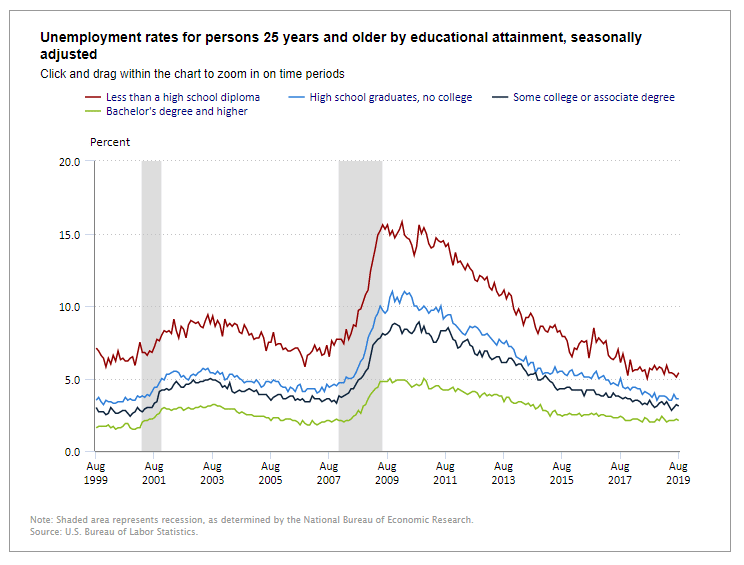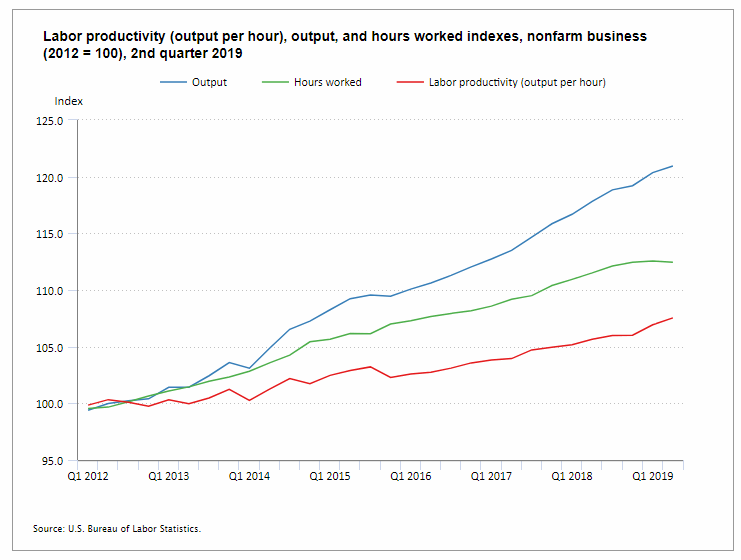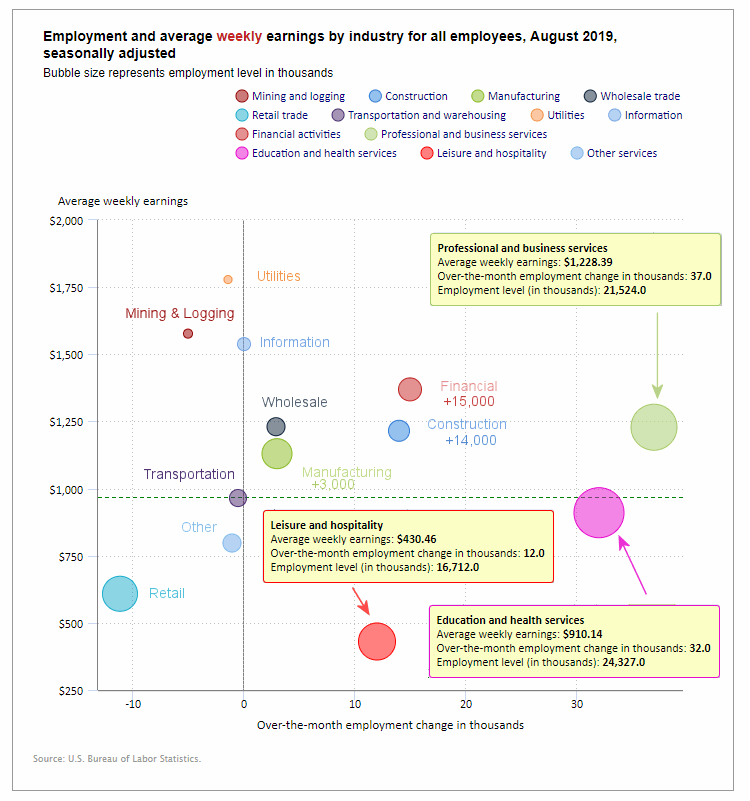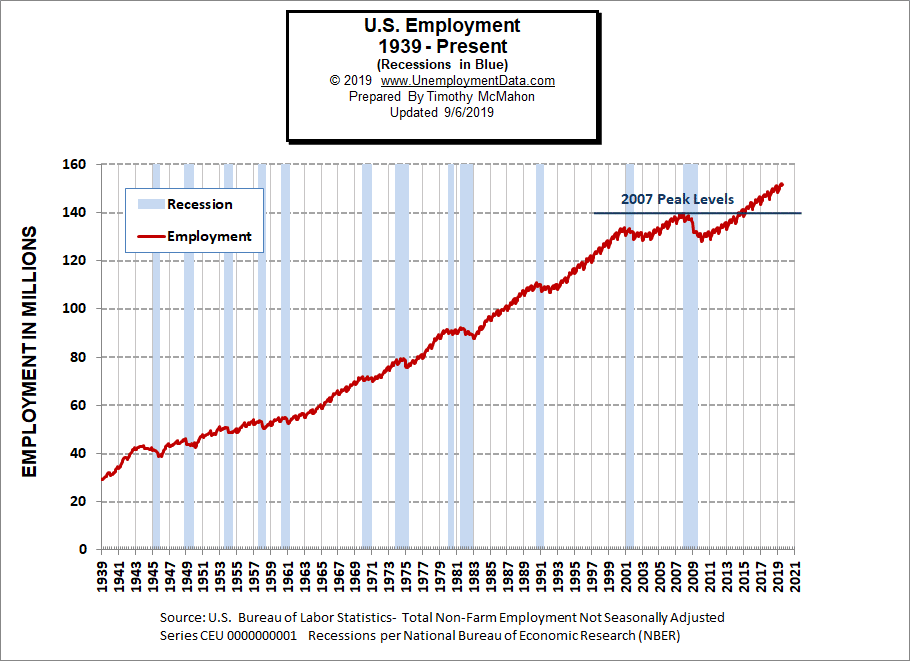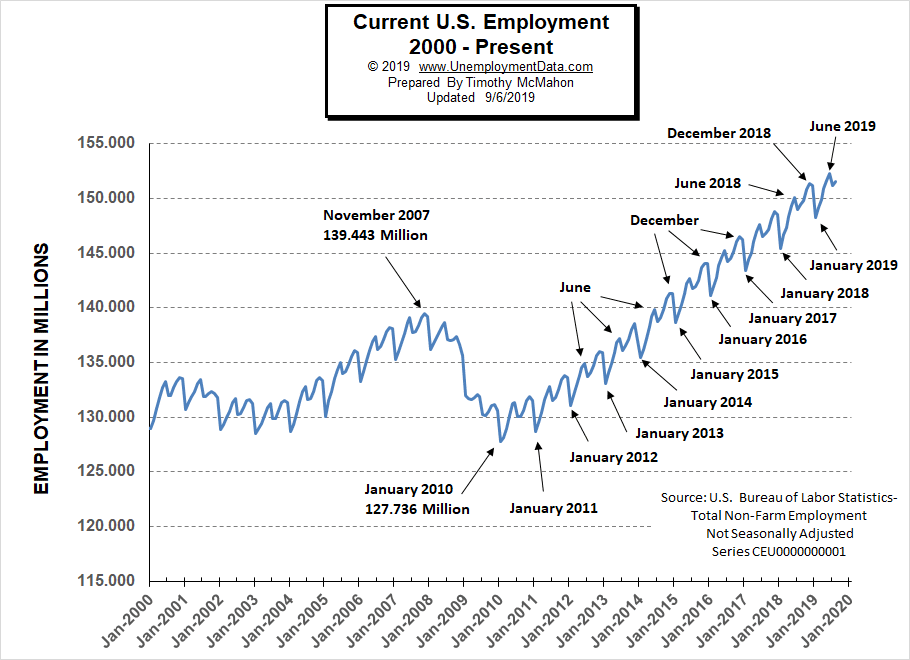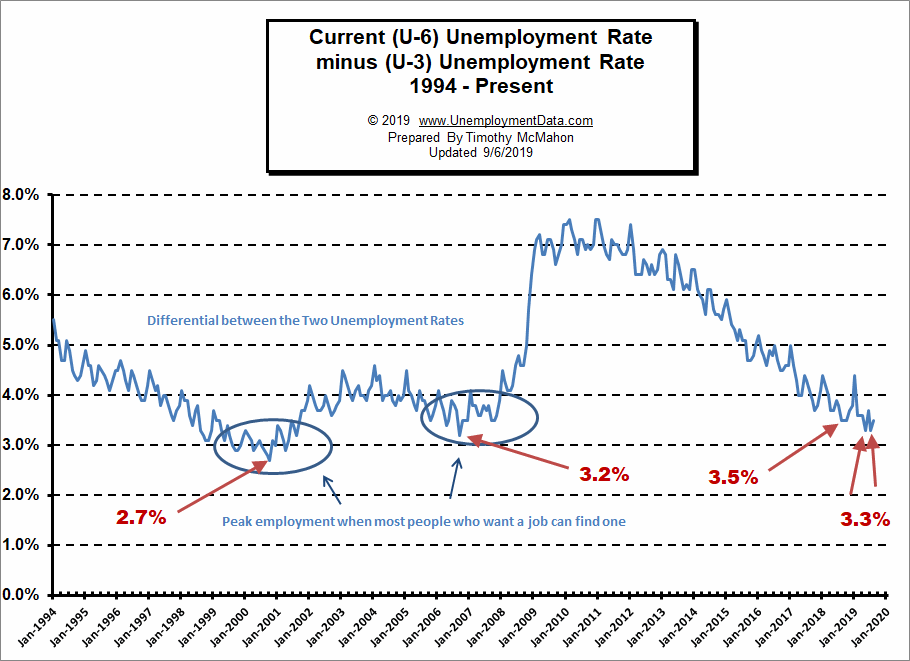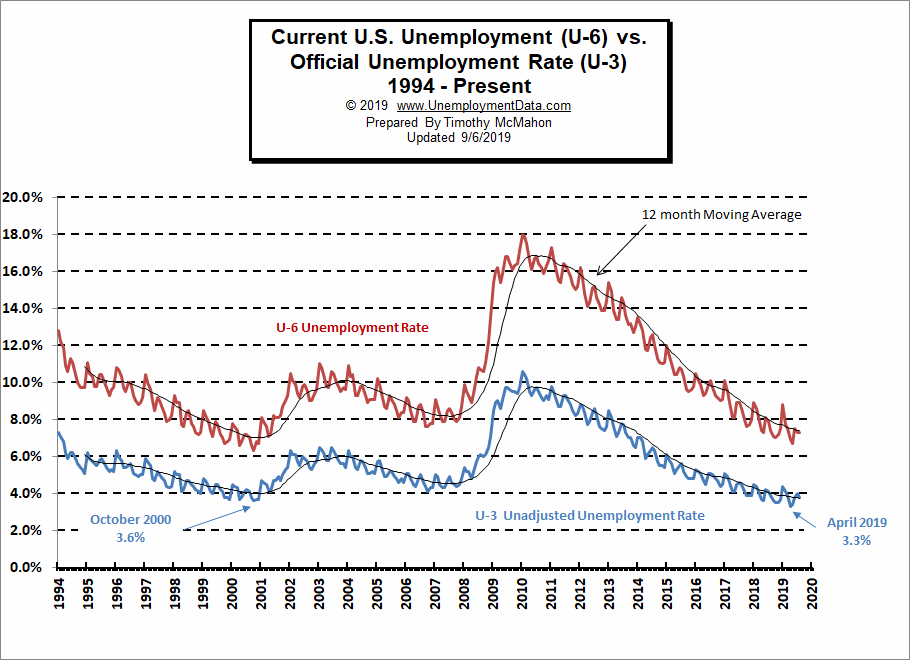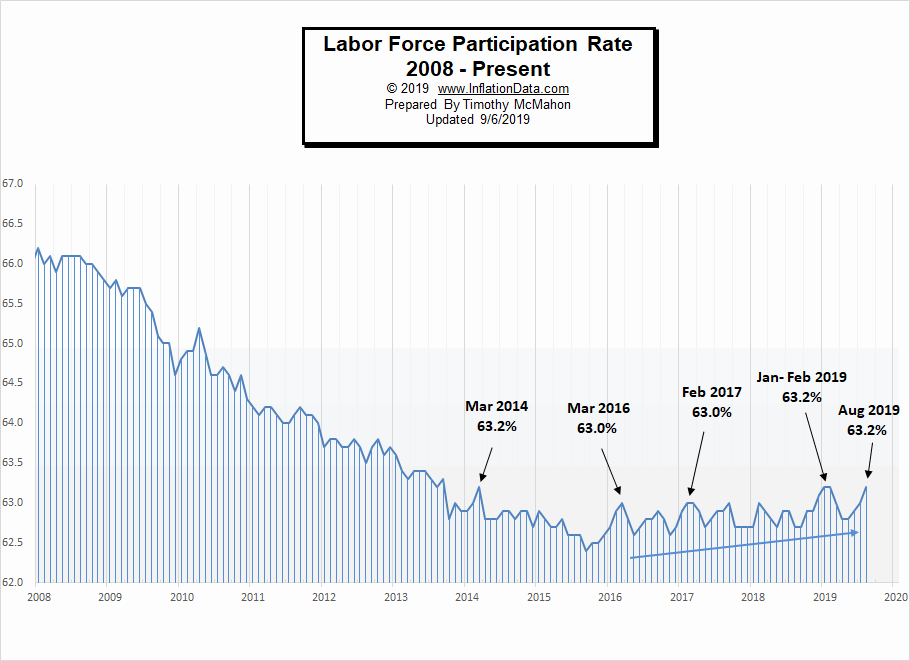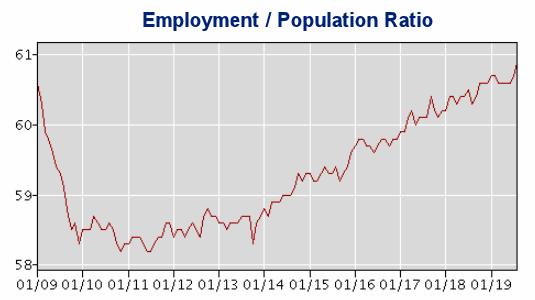The U.S. Bureau of Labor Statistics (BLS) released its employment / unemployment report for August on September 6th. Unemployment is still near record lows. According to the BLS, the “Seasonally Adjusted” Unemployment Rate for August is unchanged at 3.7% for the 3rd month in a row. But up from 3.6% in May and down from 3.8% in February and March.
According to the Commissioner of the U.S. Bureau of Labor Statistics:
“Total nonfarm payroll employment rose by 130,000 in August, and the unemployment rate was unchanged at 3.7 percent, the U.S. Bureau of Labor Statistics reported today. Employment in federal government rose, largely reflecting the hiring of temporary workers for the 2020 Census. Notable job gains also occurred in health care and financial activities, while mining lost jobs.”
Of course, he is talking about “Seasonally Adjusted Jobs” in reality there were 151.517 million people employed in August up from 151.169 million employed in July. Although the BLS originally reported 151.183 jobs for July.
For more info see our Current Unemployment Chart and Current U.S. Employment Chart commentary:
Key August Employment and Unemployment Numbers
This month’s Unemployment report was full of positive news.
- Seasonally adjusted Unemployment remained at historically low levels.
- Unadjusted U-3 was Down.
- Unadjusted U-6 remains good.
- Labor Force Participation Up Again
- Unadjusted Employment Up
Key factors in the BLS report were:
Health care employment increased by 24,000 and 392,000 over the past 12 months.
Financial activities employment rose by 15,000, with nearly half of the gain occurring in insurance carriers and related activities (+7,000). Financial activities has added 111,000 jobs over the year.
Not sure if this is good or bad but…
“Social assistance employment continued on an upward trend in August (+13,000). Within the industry, individual and family services added 17,000 jobs. Social assistance has added 100,000 jobs in the last 6 months.”
See Current Unemployment Chart for more info.
Unemployment Rates by Educational Attainment
As we can see from the above chart whether it is during a recessionary period (grey shaded areas) or during more normal periods your education plays a major part in whether you are unemployed. At the peak of the recession in June of 2009, those with a Bachelor’s Degree suffered a 4.8% unemployment rate while those with some college or an Associate’s Degree had an 8.1% Unemployment Rate. Worse off were those with only a High School Degree who had a 10% unemployment rate and those who did not finish High School suffered the worst with 15.6% unemployment. But even today with one of the lowest unemployment rates in history education still makes a difference. Unfortunately, the chart does not include a category for individuals with a trade school degree. I find it hard to believe that people stop needing plumbers just because the economy is in a slump. Although during a recession building construction like all commerce will slack off causing a decrease in the need for those who work in new construction.
Data Source: BLS Unemployment by Education
Labor Productivity
Labor productivity has increased by about 21% in the last 7 years. This is partially due to an increase in the number of hours worked but also due to an increase in output per hour.
Data Source: BLS Labor Productivity
Employment by Sector
The employment “bubble chart” gives us a good representation of how each sector of the economy is doing (employment wise). As we can see from the chart below, the biggest gainer (furthest to the right on the chart) was Professional and Business Services adding 37,000 jobs. Education and Health Services added 32,000, Leisure and Hospitality added 12,000 jobs, Financial Services added 15,000 jobs, Construction added 14,000 jobs, Manufacturing added 3,000 jobs and Wholesale added 2,900 jobs.
There are five sectors to the left of the vertical zero line this month, meaning that they lost employees (plus one other that was exactly on the line). The biggest loser is retail with a loss of -11,100 seasonally adjusted jobs. Another big loser is Mining and Logging -5,000 jobs. Utilities lost -1,400 jobs. Other lost -1,000 jobs and Transportation lost -500 jobs.
Average weekly wages rose by ¾%. It was $959.76 in June and fell to $959.71 in July and rose to $966.98 in August.
(See the table below for details.)
How to read this chart:
Bubbles location on the chart tell us two things:
- Change in Employment Levels over the most recent month.
- Average Weekly earnings.
- The further to the right the bubble the larger the increase in the number of jobs.
- The higher up on the chart the larger the average salary.
Bubble Size tells us:
- Total Employment for the sector.
- Larger bubbles mean more people are employed in that sector.
Employment and Average Weekly Earnings by Industry
August 2019, Seasonally Adjusted
| Industry | Monthly Increase | Average Weekly Earnings | Employment Level |
| Total Private Employment | 96,000 | $966.98 | 128,950,000 |
| Mining and Logging | -5,000 | $1,576.98 | 747,000 |
| Construction | 14,000 | $1,215.10 | 7,514,000 |
| Manufacturing | 3,000 | $1,129.90 | 12,853,000 |
| Wholesale trade | 2,900 | $1,230.35 | 5,944,300 |
| Retail trade | -11,300 | $608.30 | 15,746,600 |
| Transportation and Warehousing | -500 | $964.61 | 5,562,800 |
| Utilities | -1,400 | $1,778.26 | |
| Information | 0 | $1,538.03 | 2,828,000 |
| Financial Activities | 15,000 | $1,369.26 | 8,694,000 |
| Professional and Business Services | 37,000 | $1,228.39 | 21,524,000 |
| Education and Health Services | 32,000 | $910.14 | 24,327,000 |
| Leisure and Hospitality | 12,000 | $430.46 | 16,712,000 |
| Other Services | -1,000 | $797.23 | 5,945,000 |
Previous Record Low Unemployment (Seasonally Adjusted U-3)
If we consider anything 4% or below as “low” we have had a few “low” stretches as we can see in the table below.
(4% or below in Green)
| Jan | Feb | Mar | Apr | May | Jun | Jul | Aug | Sep | Oct | Nov | Dec | |
| 1950 | 6.5% | 6.4% | 6.3% | 5.8% | 5.5% | 5.4% | 5.0% | 4.5% | 4.4% | 4.2% | 4.2% | 4.3% |
| 1951 | 3.7% | 3.4% | 3.4% | 3.1% | 3.0% | 3.2% | 3.1% | 3.1% | 3.3% | 3.5% | 3.5% | 3.1% |
| 1952 | 3.2% | 3.1% | 2.9% | 2.9% | 3.0% | 3.0% | 3.2% | 3.4% | 3.1% | 3.0% | 2.8% | 2.7% |
| 1953 | 2.9% | 2.6% | 2.6% | 2.7% | 2.5% | 2.5% | 2.6% | 2.7% | 2.9% | 3.1% | 3.5% | 4.5% |
| 1954 | 4.9% | 5.2% | 5.7% | 5.9% | 5.9% | 5.6% | 5.8% | 6.0% | 6.1% | 5.7% | 5.3% | 5.0% |
| 1955 | 4.9% | 4.7% | 4.6% | 4.7% | 4.3% | 4.2% | 4.0% | 4.2% | 4.1% | 4.3% | 4.2% | 4.2% |
| 1956 | 4.0% | 3.9% | 4.2% | 4.0% | 4.3% | 4.3% | 4.4% | 4.1% | 3.9% | 3.9% | 4.3% | 4.2% |
| 1957 | 4.2% | 3.9% | 3.7% | 3.9% | 4.1% | 4.3% | 4.2% | 4.1% | 4.4% | 4.5% | 5.1% | 5.2% |
| 1958 | 5.8% | 6.4% | 6.7% | 7.4% | 7.4% | 7.3% | 7.5% | 7.4% | 7.1% | 6.7% | 6.2% | 6.2% |
| … | … | … | … | … | … | … | … | … | … | … | … | … |
| 1965 | 4.9% | 5.1% | 4.7% | 4.8% | 4.6% | 4.6% | 4.4% | 4.4% | 4.3% | 4.2% | 4.1% | 4.0% |
| 1966 | 4.0% | 3.8% | 3.8% | 3.8% | 3.9% | 3.8% | 3.8% | 3.8% | 3.7% | 3.7% | 3.6% | 3.8% |
| 1967 | 3.9% | 3.8% | 3.8% | 3.8% | 3.8% | 3.9% | 3.8% | 3.8% | 3.8% | 4.0% | 3.9% | 3.8% |
| 1968 | 3.7% | 3.8% | 3.7% | 3.5% | 3.5% | 3.7% | 3.7% | 3.5% | 3.4% | 3.4% | 3.4% | 3.4% |
| 1969 | 3.4% | 3.4% | 3.4% | 3.4% | 3.4% | 3.5% | 3.5% | 3.5% | 3.7% | 3.7% | 3.5% | 3.5% |
| 1970 | 3.9% | 4.2% | 4.4% | 4.6% | 4.8% | 4.9% | 5.0% | 5.1% | 5.4% | 5.5% | 5.9% | 6.1% |
| … | … | … | … | … | … | … | … | … | … | … | … | … |
| 1999 | 4.3% | 4.4% | 4.2% | 4.3% | 4.2% | 4.3% | 4.3% | 4.2% | 4.2% | 4.1% | 4.1% | 4.0% |
| 2000 | 4.0% | 4.1% | 4.0% | 3.8% | 4.0% | 4.0% | 4.0% | 4.1% | 3.9% | 3.9% | 3.9% | 3.9% |
| 2001 | 4.2% | 4.2% | 4.3% | 4.4% | 4.3% | 4.5% | 4.6% | 4.9% | 5.0% | 5.3% | 5.5% | 5.7% |
| … | … | … | … | … | … | … | … | … | … | … | … | … |
| 2018 | 4.1% | 4.1% | 4.1% | 3.9% | 3.8% | 4.0% | 3.9% | 3.9% | 3.7% | 3.7% | 3.7% | 3.9% |
| 2019 | 4.0% | 3.8% | 3.8% | 3.6% | 3.6% | 3.7% | 3.7% | 3.7% |
Employment
Historically employment is closely tied to recessions and that is no accident. One of the primary factors in calculating whether the economy is officially in a recession is an increase in the unemployment rate. The chart below provides the Historical Employment Data overlaid on blue bars showing periods of official recessions.
In August employment rose to 151.517 million from 151.169 million.
As we can see from the table below from November 2007 to January 2008 there were over 3 million jobs lost but that actually wasn’t all that surprising. Typically January suffers from a reduction in Seasonal workers. Even good years like 2005-2006 saw a reduction of 3 million workers and January 2008 employment levels were still above January 2007 levels. But by January 2009, year-over-year losses exceeded 4 million. By 2010 the economy had lost another 4.2 million. 2011 showed almost a million jobs improvement but the economy was still on shaky ground. It wasn’t until January 2014 that the economy reached January 2007 levels and January 2015 exceeded January 2008 levels.
| Date | Employment in Millions |
| January 2007 | 135.335 |
| November 2007 (Peak) | 139.510 |
| January 2008 | 136.268 |
| January 2009 | 132.042 |
| January 2010 | 127.820 |
| January 2011 | 128.778 |
| January 2012 | 131.113 |
| January 2013 | 133.081 |
| January 2014 | 135.488 |
| January 2015 | 138.511 |
| January 2016 | 141.088 |
| January 2017 | 143.393 |
| January 2018 | 145.428 |
| January 2019 | 148.295 |
| February 2019 | 149.148 |
| March 2019 | 149.864 |
| April 2019 | 150.938 |
| May 2019 | 151.610 |
| June 2019 | 152.243 |
| July 2019 | 151.169 |
| August 2019 | 151.517 |
Employment Numbers are “Preliminary” for two months before the BLS considers them finalized due to late coming data.
Current Employment
From the above current employment chart, we can see that the low point for each year occurs in January and then a small peak occurs around June with a slight drop around July and then the highest peak in employment happens in November/December. So the current drop in July is entirely normal.
See Historical Employment and Current Employment for more info.
The Differential between U3 and U6
The previous lows on this chart are at 2.7% in October 2000 and 3.2% in September 2006. In August, September, and October of 2018, the differential between unadjusted U-3 and unadjusted U-6 dropped to 3.5% indicating that we were getting closer to “full employment” but then in December, the U-6 ticked up to 7.5% from 7.2% a month earlier and the differential ticked back up to 3.8%.
Typically the differential peaks in January and this year was no exception. In January 2019 U-6 shot up to 8.8% and U-3 was 4.4% for a differential of 4.4%. In February the differential fell back to 3.6%. From there we saw it fall to 3.3% in May rise in June and then fall back to 3.3% in July and then rose again in August.
See Current U-6 Unemployment Rate for more info.
U-6 Unemployment
Current U-6 Unemployment Rate for August 2019 is 7.3% Previously 7.3% in July, 7.5% in June, 6.7% in May, and 8.8% in January.
Unadjusted U-6 is unchanged from 7.3% in July while Unadjusted U-3 is down from 4.0% to 3.8%.
See Unadjusted U-6 unemployment for more info.
Labor Force Participation Rate
The Current Labor Force Participation Rate for August 2019 is up from 63.0% to 63.2%
See Labor Force Participation Rate for more information.
Employment-Population Ratio
The index many people think of when they hear the term Labor Force Participation Rate might be better described by the Employment-Population Ratio. This index shows the percentage of the entire population that is working. In many ways, it is a better index than the LFPR or the Unemployment rate. Current levels are back in the range of where they were in 2009 even though the population has drastically increased.
Here are some articles you might enjoy in case you missed them:
Read more on UnemploymentData.com.
- Injury at Work? Know Your Rights to Compensation and FMLA
- Taking Your Real Estate Business to the Next Level
- From Testing to the Bar—4 Tips for Starting Law School
- How Those With Autism Can Strengthen Their Odds in Applying for Jobs
- How to Handle Your Pay Being Withheld at Work
From InflationData.com
- How Does Inflation Affect the Cost of Insurance?
- July Inflation Report
- Why Does China Want to Lower the Value of Its Currency?
- How High Inflation Drives Countries Towards Crypto
- June Inflation: Down Again
- Gold Price and Its Relationship with Inflation
From Financial Trend Forecaster
- Asteroid Mining: Science Fiction or Science?
- Why Gold Prices Are About To Skyrocket Even Higher
- From Ice Cream To Toilet Seats: The Most Bizarre Uses For Gold
- Turning Nuclear Waste into “Perpetual” Batteries
- 4 Precious Metals to Consider
- Almost Inverted Yield Dip Is Bullish for Stocks
- Summer of Love for Gold Bulls: How “Quandary” Became Clarity
- Message from the Stock/Bond Ratio
- Do Facts Support Doom and Gloom or Higher Highs for Stocks and/or Gold?
- Want to See What’s Next for the Economy? Try This.
From OptioMoney.com
- Avoid a Money Pit: 4 Vital Inspection Items before Buying an Older Home
- 3 Benefits of Finding a Reliable Family Lawyer
- 4 Hidden Car Costs
- Buying and Selling Ranch Land: A Beginner’s Guide
- 4 Tips to Cover the Bills When Your Disability Keeps You Home
- Investments You’ll Thank Yourself for in Twenty Years
From Your Family Finances

